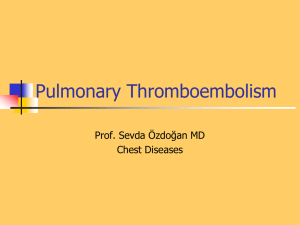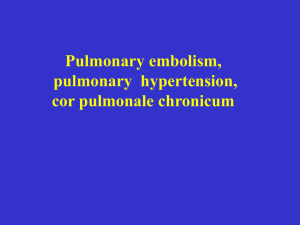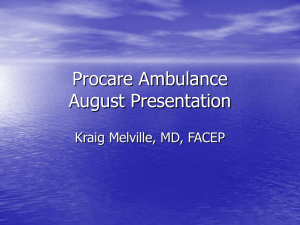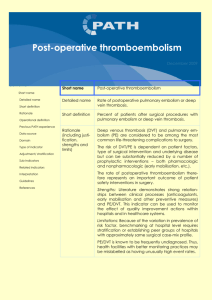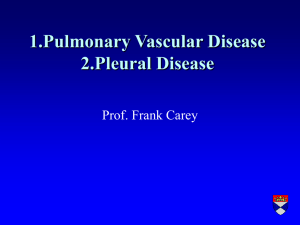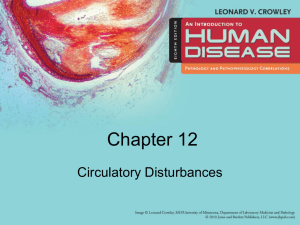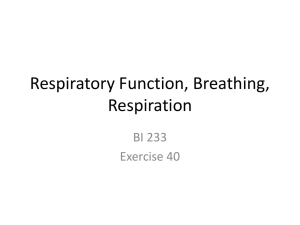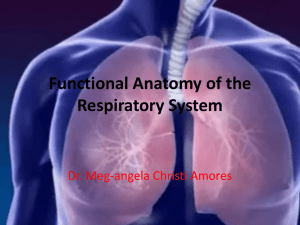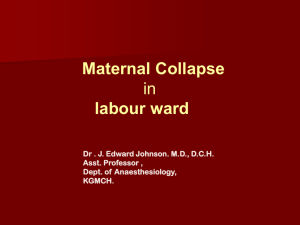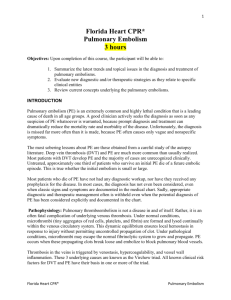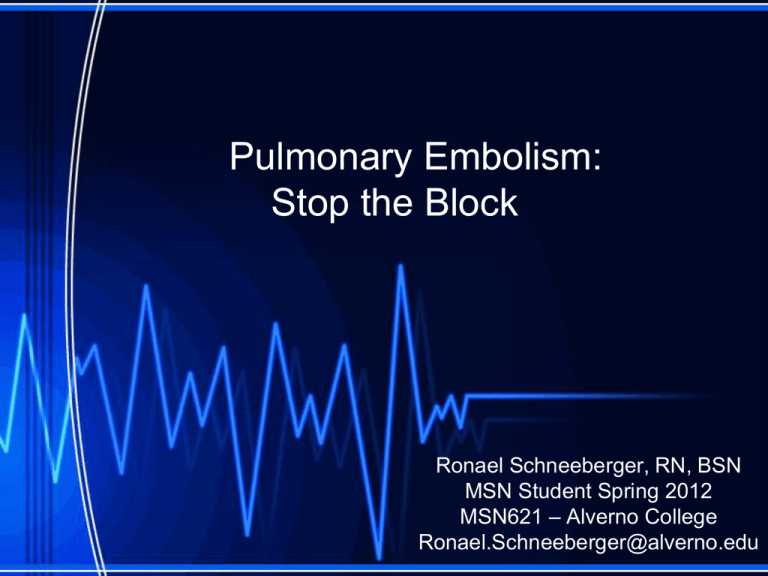
Pulmonary Embolism:
Stop the Block
Ronael Schneeberger, RN, BSN
MSN Student Spring 2012
MSN621 – Alverno College
Ronael.Schneeberger@alverno.edu
Objectives of Tutorial
o Define pulmonary embolism (PE).
o Identify what makes PE different than
deep vein thrombosis (DVT).
o Detect risk factors that contribute to PE.
o Identify common signs and symptoms of
PE.
o Isolate routine tests ordered to diagnose
PE.
o Recognize standard treatments for PE.
Patient Scenario
o 44 year old, female.
o Presents with complaints of a non-productive cough, episodes of
difficulty breathing the last couple of days, and a feeling of her chest
burning with cough.
Where do you think this information will take you?
Emergency Department (ED)
Microsoft Clip Art
What is Pulmonary Embolism?
o Pulmonary Embolism (PE) occurs when a bloodborne substance (most often a DVT) lodges in a
branch of the pulmonary artery and obstructs flow.
o Bits of plaques, fat, and air bubbles may also be
called emboli, thus causing a pulmonary embolism.
For example, if plaques involved in atherosclerosis
break free and move through the blood stream, they
may lodge in the branch of the pulmonary artery and
cause a PE.
o This tutorial focuses on PE
due to thrombus only.
Porth & Matfin 2009
Microsoft Clip Art
Pathway from DVT to PE
o Almost all pulmonary emboli are thrombi that are
a result of deep vein thrombosis (DVT) of the
lower extremities.
o Thus, most likely the clot started in the femoral,
popliteal, or iliac vein. From there, it traveled
through the inferior vena cava, then to the right
atrium of the heart and onto the right ventricle of
the heart. Finally, it stops somewhere in a branch
of the pulmonary artery.
Thompson & Hales 2011
Example Pathway of DVT to PE
Adapted from Wikimedia and Clker.com
Our Patient in the ED Now Tells Us:
o She has a history of hip surgery 2 months previously.
o She smokes a ½ pack of cigarettes per day.
o After her last child was born she developed a DVT in her
lower leg.
o Her daily medication includes an oral contraceptive pill
(she is unsure of name).
o She was seen twice over the last 6 weeks for cough and
completed Zithromax and Levaquin but this cough is just
getting worse and now her chest bothers her.
Microsoft Clip Art
What Are the Risk Factors for PE?
o Venous stasis and venous endothelial injury
o Prolonged bed rest
o Trauma
o Surgery
o Childbirth
o
o
o
o
Fracture of hip & femur
Myocardial infarction (MI)
Congested heart failure
Spinal cord injury
o Hypercoagulability states
o Thrombophilias (antithrombin deficiency, protein C and S deficiencies,
and factor V Leiden mutation).
o Cancer
o Use or oral contraceptives (increased with smoking)
o Pregnancy
o Previous history of DVT and/or PE or concurrent diagnosis of DVT.
Microsoft Clip Art
Porth & Matfin 2009
Let’s Evaluate
o Our patient that presented to the ED had many risk
factors for PE formation. Can you name them?
Recent surgery, history of
DVT, and recent course
of antibiotics.
Try again! Recent surgery
and previous DVT do
increase the risk of PE
formation. However, recent
antibiotic use is not a risk
factor for PE.
Recent surgery, history of
DVT, smoker, and taking
an oral contraceptive pill
Right! Recent surgery leads
to venous stasis or
endothelial damage.
Smoking and contraceptive
pill increase risk by
increasing resistance to
anticoagulants.
And Now Our Patient in the ED Adds:
o She has had shortness of breath with activity for the
last 6 weeks.
o You have now checked her vitals: Blood Pressure is
90/45, Temperature is 98.8, Pulse is 130, Respiratory
rate 24, and pulse ox 92%.
o And remember today she presents with complaints of
a non-productive cough, episodes of difficulty
breathing the last couple of days, and a feeling of her
chest burning with cough.
Signs and Symptoms of PE
Embolism in the lung will cut off blood flow beyond the point where it is lodged.
This stops the normal exchange of oxygen and carbon dioxide in the affected
artery. The heart is now also pumping against a blocked vessel. What signs
and symptoms might a patient present with if they have a PE?
Chest Pain
Right! A blood clot becomes
lodged in the pulmonary
artery, blocking blood flow to
lung tissue causing chest
discomfort.
Hypertension
Oops! The patient may have
hypotension not
hypertension. The clot blocks
the outflow of blood from the
right side of the heart to the
lungs leading to hypotension.
Cough
Normal Breathing
Right! Bronchoconstriction in
the lung due to impaired
pulmonary blood flow may
cause this.
Try again. Let us think about
this. If air exchange is
impaired due a blockage you
may have shortness of
breath (dyspnea).
Decreased Pulse
Low Oxygen Saturation
Try again. Pulse increases.
Not enough O2 is being
delivered and your heart is
working harder pumping
against a blocked vessel.
Right! Due to impaired gas
exchange. Remember normal
exchange of oxygen and
carbon dioxide is stopped
due to the embolism.
Do Patients Always Have
Signs/Symptoms of PE?
o The situation used in this tutorial is an ideal situation.
o Pulmonary embolism is frequently
asymptomatic (Thompson & Hales 2011).
o Approximately one third of patients with deep venous
thrombosis have silent pulmonary embolism (Stein, et
al 2010).
Microsoft Clip Art
Common Tests Used in Diagnosis
D-dimer – If this test is negative not likely a PE. If positive
you must evaluate further for PE, but it may be elevated
due to many other reasons.
Chest X-ray – May show cardiomegaly, which is the most
common chest radiographic abnormality associated with
acute pulmonary embolism (Elliott et al. 2000).
Chest CT – Will show the blockage by the emboli. This is
main tool used in diagnosing. Click here to see CT
example (Thompson & Hales 2011).
Other Tests You May See
EKG – May show signs of right side heart strain or sinus
tachycardia. This is mainly used to rule out myocardial
infarction and is not a specific test (Thompson & Hales
2011). Click here to see EKG example.
Pulmonary Angiography – “gold standard” However, not used
often in practice due to being so invasive (Porth &Matfin
2009).
Blood Gas - may show reduced PaO2, reduced PaCO2 due
to hyperventilation, or acidosis. Studies are showing this may
not be a reliable method to diagnose PE and today may not
be ordered routinely (Rodger et al. 2000).
Our Patient Has Some Tests Completed:
o The following tests are ordered to begin:
electrocardiogram (EKG), chest x-ray, D-dimer.
Microsoft Clip Art
Our Patient’s Tests Reveal…..
o What do you think the patient’s initial tests would
reveal if she has a PE?
D-dimer Normal
Try again! It was elevated! Ddimer is a small protein
fragment present in the blood
after a blood clot is degraded
by fibrinolysis. This can be
measured with a blood test.
If positive you must continue
to evaluate for PE. If negative
you can almost always rule
out PE.
Chest X-ray Abnormal
Correct! It revealed
cardiomegaly. Enlarged 50%
compared to x-ray from 3
weeks ago.
EKG Shows Sinus
Tachycardia
Right! Sinus tachycardia may
be an indicator of PE.
Microsoft Clip Art
So What Would You Order Next?
o The patient now has an elevated D-dimer,
abnormal chest x-ray, and EKG changes what
test would you order next?
Pulmonary Angiography
Chest CT
Try Again! This is a great
guess but in practice, since
this test is so invasive it is
rarely used to diagnose PE. It
is however, the “gold
standard.”
Correct! It is the least
invasive way and most
accurate way to identify the
blockage by the emboli.
The Result Is In…….
o The patient’s CT revealed a large saddle embolus.
Click here to see a picture of a saddle embolus.
o Now we need to treat this patient. Let’s explore our
options.
Microsoft Clip Art
Treatment
o In patients with large or multiple emboli and
associated hemodynamic instability, thrombolytic
drug therapy may be used (Porth & Matfin 2009).
o Heparin, intravenously (IV) or low molecular weight
heparin (LMWH), subcutaneously, follows
thrombolytic therapy or is the main treatment for
smaller, single emboli. LMWH has been shown to be
safer and as effective as heparin (Ramzi & Leeper
2004).
o Warfarin, orally, is initiated to prevent the
reoccurrence of clots.
Let’s Remember How These
Medications Work!
(Bowne 2004-2010)
Thrombolytic Drug Therapy
o Thrombolytic drugs include Urokinase, Streptokinase,
and recombinant Tissue Plasminogen Activator
(rTPA).
o Dosing is based on the patient weight and
administered intravenously (IV).
o This drug is used cautiously due to significant side
effects including hemorrhage.
o There is not set criteria for when the use of these
medications should be used to treat PE.
(Almoosa 2002)
Thrombolytic Therapy Continued….
o During administration of thrombolytics, laboratory
monitoring is unnecessary. After the infusion is given,
PTT should be measured. If it is less than 2.5 times
the control value, a heparin infusion should be started
and adjusted to maintain a PTT of 1.5 to 2.5 times
the control. If the PTT initially is greater than 2.5
times the control it should be checked every four
hours, and heparin should be started if the PTT drops
below this level.
(Almoosa 2002)
Information on Heparin
o Standard treatment of PE requires a continuous IV
infusion of heparin with the dose adjusted to a target
a PTT of 60 to 80 seconds. IV heparin is
administered throughout the hospitalization, which
typically averages 5 to 7 days, until the warfarin has
become fully effective (Goldhaber & Grasso-Correnti
2002).
o More providers are using low molecular weight
heparin (LMWH) injections, called Lovenox or
Innohep, rather than IV heparin. LMWH has been
shown to have advantages and be just as effective as
heparin (Ramzi & Leeper 2004).
Information on Warfarin
o Warfarin (coumadin) cannot be prescribed in a fixed or weightadjusted dose. Instead, the dose must be adjusted according to
a laboratory blood test that measures the length of time it takes
for clotting to begin, or prothrombin time (PT).
o The test is standardized to account for different laboratory
processes and is called the International Normalized Ratio
(INR).
o The INR of a healthy individual not taking warfarin is 1.0. The
INR increases with increasing intensity of anticoagulation.
o For patients with DVT or PE, the usual target INR is 2.0 to 3.0.
The target INR may be raised to levels as high as 4.0 for
intensive coagulation.
(Goldhaber & Grasso-Correnti 2002)
Let’s Check Your Knowledge
o What medication do you expect to see ordered
immediately for our emergency department patient
with a saddle emboli and low blood pressure?
Warfarin
Good try! Warfarin prevents
further clot formation by
interfering with the synthesis
of clotting factors.
Heparin
Try again. Heparin prevents
further clot formation by
increasing the function of
antithrombin. It is used for
small or single emboli.
rTPA
Correct! rTPA works to break
down the current clot by
activating plasminogen which
forms plasmin to break down
the clot. It is it used in large
lots like a saddle embolism
and when there
hemodynamic instability
(hypotension).
Summary
o Pulmonary embolism is a common and
sometimes fatal condition.
o Prompt diagnosis and treatment can reduce
mortality.
o Remember, this tutorial demonstrated the ideal
clinical situation.
Microsoft Clip Art
Literature Cited
o
o
o
o
o
o
o
Almoosa, K. (2002). Is thrombolytic therapy effective for pulmonary embolism? American
Family Physician, 65(6), 1097-1103.
Goldhaber, S. & Grasso-Correnti, N. (2002). Treatment of blood clots. Circulation. 106, 138140.
Porth, C.M. & Matfin, G. (2009). Pathophysiology: Concepts of altered health. Philadelphia,
PA: Lippincott, Williams & Wilkins.
Ramzi, D. & Leeper, K. (2004). DVT and pulmonary embolism: Part II. Treatment and
prevention. American Family Physician, 69(12), 2841-2848.
Rodger, M., Carrier, M., Jones, G., Rasuli, P., Raymond, F., Djunaedi, H., & Wells, P.
(2000). Diagnostic value of arterial blood gas measurement in suspected pulmonary
embolism. American Journal of Respiratory and Critical Care Medicine, 162(6),
2105-2108.
Stein, P., Matta, F., Musani, M., & Diaczok, B. (2010). Silent pulmonary embolism in patients
with deep venous thrombosis: A systematic review. American Journal of Medicine,
123(5), 426-431.
Thompson, B.T. & Hales, C. (2011, December 23). Overview of acute pulmonary embolism.
Retrieved February 11, 2012 from UpToDate online textbook:
http://www.uptodate.com.
Images Cited
o
Bowne, Pat. Hemostasis. Retrieved February 17, 2012 with permission from Bowne, P.S.,
2004-2010, PATHO Interactive Physiology Tutorials:
http://faculty.alverno.edu/bowneps/hemostasis/h19.htm
o
Clker.com. (n.d.) Retrieved March 4, 2012:
http://www.clker.com/clipart28685.html
o
EKGinterpretation.com. (n.d.) Retrieved February 17, 2012 with permission.
http://www.ekginterpretation.com/library/acute-pulmonary-embolism/
o
Wiki. (n.d.) Retrieved March 14, 2012: http://en.wikipedia.org/wiki/File:SaddlePE.PNG
o
Wiki. (n.d.) Retrieved March 1, 2012:
http://en.wikipedia.org/wiki/File:Saddle%20thromboembolus.jpg
o
Wiki. (n.d) Retrieved March 4, 2012:
http://commons.wikimedia.org/wiki/File:Diagram_of_the_human_heart_(cropped).svg

